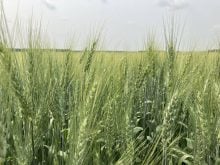There aren’t many downsides to spraying at night, according to a researcher and a farmer who regularly sprays after dark.
Bob Blackshaw, a research scientist with Agriculture Canada, has compared the results of spraying barley, peas and camelina during day and night and found no significant differences in weed kill related to the timing of the application.
His tests included Roundup, Liberty, Gramoxone and Solo.
Blackshaw told farmers at the early July Farming Smarter field school that plant absorption of herbicide might be better at night in some cases because the plant cuticle is hydrated by dew and humidity.
Read Also

Why feds imposed EV tariffs
Moe and Kinew have a fight on their hands when it comes to eliminating the EV tariff. Canada has to worry about pissing off the U.S. and Mexico and hundreds of thousands of auto workers.
“A cuticle is like a sponge,” he said.
“It becomes very compressed when it’s dry but when it absorbs a bit of moisture, it becomes bigger and the pores in this cuticle then become more easily penetrated by the spray drop.”
Herbicide droplets crystallize when they dry and don’t penetrate the leaf surface. Blackshaw said the droplets can rehydrate and later be absorbed by the plant, but the necessary conditions aren’t guaranteed.
“Anything we can do to slow down droplet drying time is good.”
He said only two to four percent of herbicide that is applied in spring weed burnoff operations gets into plants and does the intended job. Whether the herbicide works by contact or through systemic action, it must somehow penetrate the plant surface.
Translocation of herbicide occurs during photosynthesis, which occurs during the day. However, night spraying can allow better initial penetration so that weed kill is more effective when photosynthesis begins the following day.
Lower or nonexistent wind is the biggest advantage of night spraying.
Among the disadvantages is the possibility of inversion, in which soil warmed during the day radiates heat at night. That can promote spray drift. Inversions are rare in spring because of lower temperatures but can occur in summer.
Reduced visibility is another disadvantage, but autosteer and GPS can mitigate the risks.
That was the case for Don Boles of Three Hills, Alta., who has done pre-seeding weed burnoff at night for many years. He began in a year with unusually high spring temperatures, which coincided with the installation of autosteer on his tractor.
“I’m a bit of a nighthawk, so that’s an upside,” he said.
“But the big advantage is usually wind. You get away from the wind.”
He was hesitant at first to spray in heavy dew conditions but said he soon noticed better results when night spraying under moist conditions.
He said visibility is an issue at night even with autosteer, but superior lighting on most modern equipment is a help.
“I think the take home from this is not to be scared of it,” Boles said.
“If you can only spray at night, go ahead and spray at night, or really early in the morning. There’s not very many downsides and in some cases it actually works better.”















